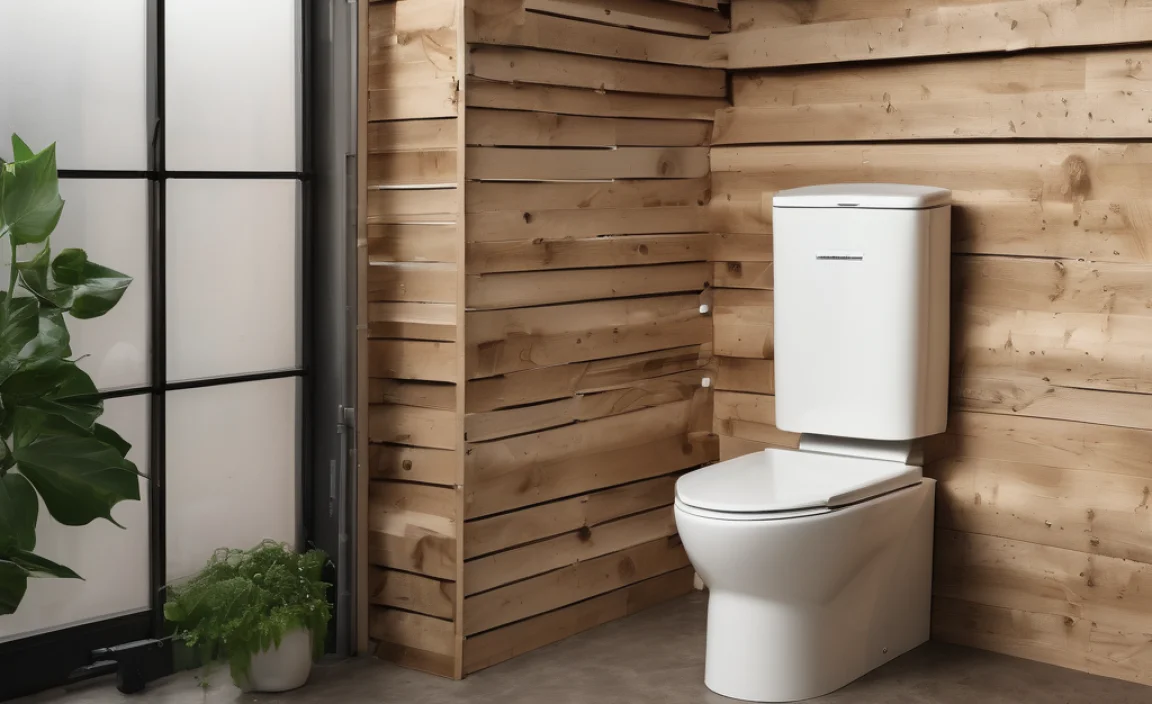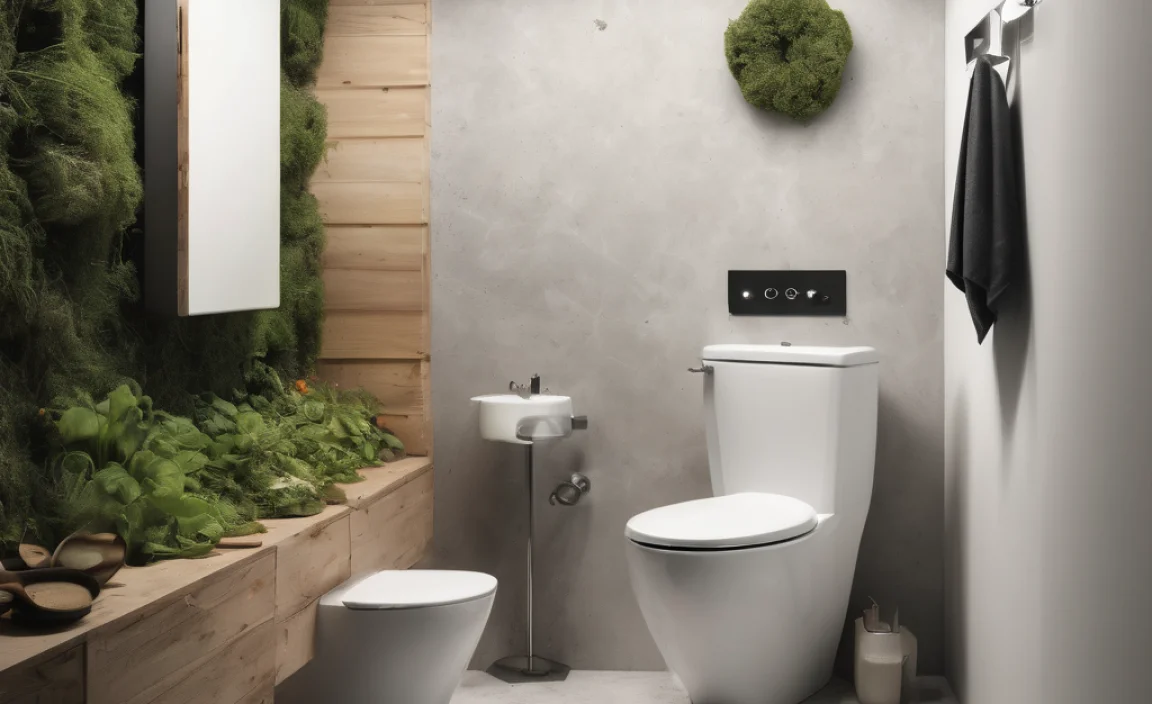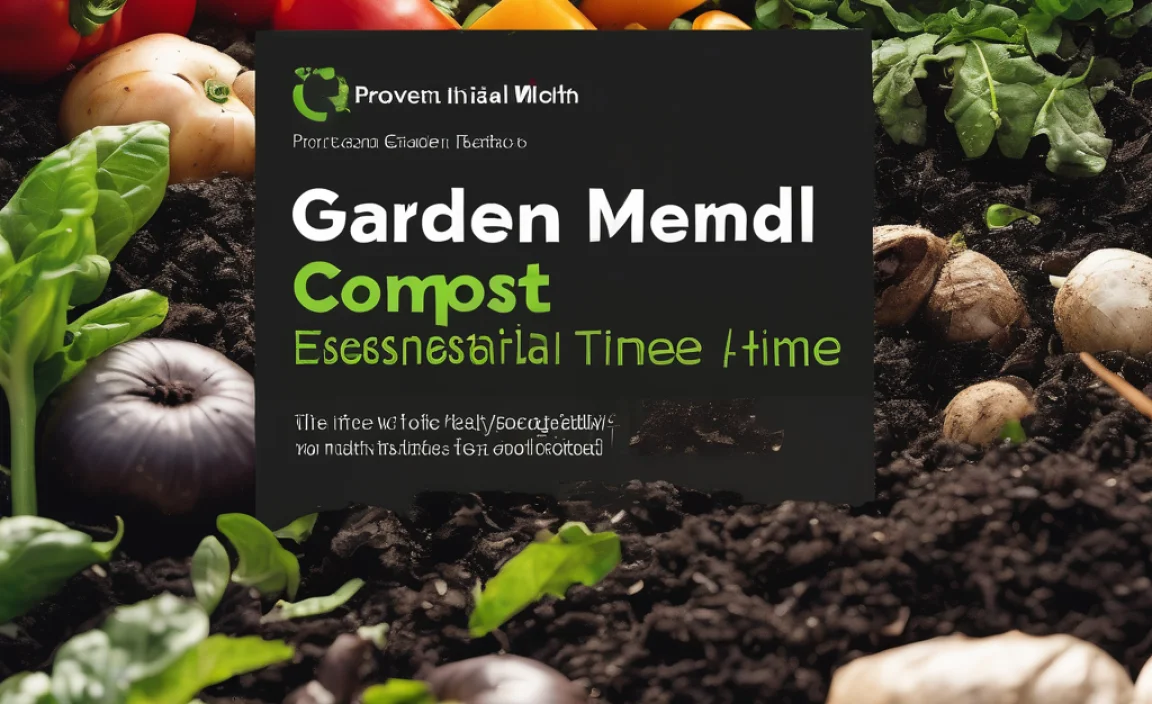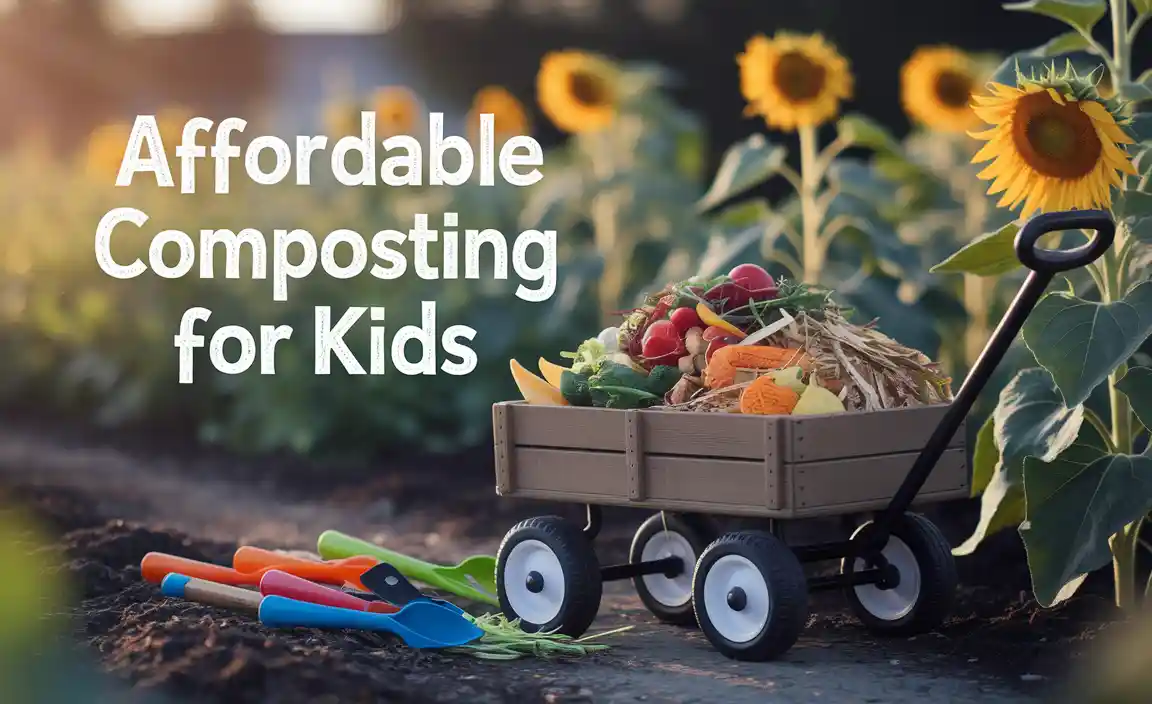Hey there! Are you thinking about composting but live in a rural area and wondering about the best way to manage temperatures? It can feel a bit daunting at first, especially when you hear about strict temperature rules. But don’t you worry! We’re going to break down everything you need to know about keeping your compost pile just right for breaking down food scraps and yard waste into that rich, black gold for your garden. It’s simpler than you think, and I’ll guide you through it step-by-step. Let’s get that compost cooking!
By the end of this guide, you’ll understand how temperature plays a crucial role in composting success in rural settings, what signs to look for, and how to adjust your methods. We’ll cover everything from the ideal heat ranges to ensure the fastest decomposition and pathogen kill to how our rural environment might affect these temperatures and what to do about it. Ready to turn your waste into garden treasure?
Composting for Rural Areas: Temperature is Key!
Composting is like a natural magic trick where organic materials like kitchen scraps and yard waste break down into nutrient-rich soil. In rural areas, we often have more space and materials, which is great for composting! A big part of making this magic happen efficiently is managing the temperature inside your compost pile. Why is temperature so important? Well, it directly impacts how quickly the beneficial microbes (tiny living things) can do their job breaking everything down. Too cold, and things go slowly. Too hot, and you can harm those helpful microbes.
For us in rural settings, understanding temperature management is essential. We have different factors that can influence our compost piles compared to city dwellers, like larger volumes of material, more varied weather patterns, and sometimes different types of compost bins or piles. Getting this temperature right helps speed up the process, reduces those less-than-pleasant composting smells, and ensures that any weed seeds or harmful pathogens are destroyed.
The Science Behind Hot Composting
When we talk about composting temperatures, we’re usually aiming for the “hot composting” phase. This is where the magic happens fastest! It relies on a thriving community of bacteria that work best within a specific warm temperature range. These microbes feast on the organic materials we put into the pile.
The ideal temperature range for hot composting is generally between 130°F (55°C) and 160°F (71°C). This “thermophilic” (heat-loving) phase is crucial for a few big reasons:
- Speedy Decomposition: The warmer it is within this range, the faster those microbes work. This means you can get finished compost in as little as 4-6 weeks, rather than months or even a year for slower, cooler composting.
- Killing Pathogens and Weed Seeds: The high heat effectively kills off harmful bacteria (like E. coli and Salmonella) and most weed seeds. This is super important if you plan to use your finished compost in your vegetable garden.
- Reducing Odors: A hot compost pile generally smells earthy and pleasant. Unpleasant odors often indicate that the pile is too wet, lacks air, or isn’t hot enough, meaning decomposition is happening anaerobically (without enough oxygen) and producing smelly compounds.
Outside this ideal range, decomposition slows down significantly. If your compost pile consistently stays below 100°F (38°C), it’s considered “cold composting.” While cold composting still works, it takes much longer, and it won’t effectively kill pathogens or weed seeds. On the flip side, if your pile gets too hot, above 160°F (71°C), you risk killing off the very microbes that are doing the work! It’s a delicate balance, but totally achievable.
Factors Affecting Compost Temperature in Rural Areas
Living in a rural area gives us some advantages for composting, but it also means we need to be aware of how our environment can affect pile temperatures. Unlike a small, contained bin on a city balcony, our larger compost piles or heaps are more exposed to the elements.
Here are some key factors to consider:
- Ambient Air Temperature: This is the most obvious one! A chilly 30°F (-1°C) day is going to cool your pile down much faster than a warm summer afternoon. Conversely, a sweltering 90°F (32°C) day can help kickstart heating. Rural areas often experience a wider swing in daily and seasonal temperatures.
- Size of Your Compost Pile: Bigger is generally better for generating and retaining heat. A small pile might struggle to heat up enough, especially in cooler weather. In rural settings, you often have more yard waste and kitchen scraps, allowing for larger, more efficient compost piles that build and hold heat well. A good rule of thumb is to aim for a pile that’s at least 3 feet x 3 feet x 3 feet (1 cubic meter).
- Moisture Content: Your compost pile needs to be moist, like a wrung-out sponge. Too dry, and the microbes can’t survive or multiply. Too wet, and air can’t get in, leading to anaerobic conditions and smelly, slow composting. Rural settings might mean more frequent watering in dry spells or better drainage to prevent waterlogging if you get a lot of rain.
- Aeration (Oxygen): Those friendly microbes need oxygen to thrive. Turning your compost pile regularly introduces fresh air. Without enough air, the pile can become anaerobic, cool down, and develop a foul odor.
- Materials Used (Carbon-to-Nitrogen Ratio): The balance of “browns” (carbon-rich materials like dry leaves, straw, shredded paper) and “greens” (nitrogen-rich materials like food scraps, grass clippings) is crucial for fueling the microbial activity. An imbalance can prevent the pile from reaching optimal temperatures. Rural areas often have an abundance of “browns.”
- Sunlight vs. Shade: A compost pile in direct, hot sun will heat up more quickly and might require more frequent watering in very hot climates. A pile in deep shade might struggle to get going during cooler months.
Understanding these elements helps us anticipate challenges and make adjustments. For example, if you know a cold snap is coming, you might add more “browns” to insulate the existing heat or ensure your pile is sufficiently large to retain warmth.
Measuring Your Compost Pile’s Temperature
You don’t need to be a scientist to measure your compost pile’s temperature! Knowing if it’s hot enough is key to efficient composting, especially when you’re dealing with the varying conditions of a rural environment.
The best tool for the job is a compost thermometer. These are long-stemmed thermometers designed to withstand heat and moisture and reach deep into your compost pile. You can find them at garden supply stores or online. They typically have a dial that clearly indicates different temperature zones:
- Cool/Decomposition Slows: Below 100°F (38°C)
- Active Decomposition/Heating Up: 100°F – 130°F (38°C – 55°C)
- Optimal Hot Composting (Thermophilic): 130°F – 160°F (55°C – 71°C)
- Too Hot/Microbes Dying: Above 160°F (71°C)
How to Use a Compost Thermometer:
- Insert the thermometer into the center of your compost pile, aiming for the hottest part. If you have a large pile, you might want to check the temperature in a few spots.
- Leave it in for a few minutes (or as directed by the thermometer’s instructions) to get an accurate reading.
- Record the temperature and note it down, especially when you’re first learning about your pile. This helps you understand its behavior over time.
What if I don’t have a compost thermometer?
While a thermometer is the most accurate way, you can get a general idea by using your senses:
- Touch: Carefully put your hand into the center of the pile. If it feels noticeably warm or hot, it’s likely in the active heating phase. If it feels lukewarm or cool, it probably needs help. Be cautious and don’t push your hand too deep into a very hot pile!
- Steam: When you turn a hot pile, you might see steam rising from it, especially on a cool morning. This is a great sign that it’s working hard!
Having a thermometer is really the best way to know for sure, and they aren’t too expensive. It takes the guesswork out of it and helps you troubleshoot if your pile isn’t heating up as expected.
When to Check Temperature
The best time to check your compost temperature is when you’ve recently turned or added new materials to the pile, as this is when heat generation is usually most active. Aim to check it every few days during the initial heating phase, and then perhaps once a week as it matures. You want to see it heat up, stay hot for a while, and then gradually cool down as the materials break down. If it heats up and then cools down very quickly, it might mean you need more nitrogen or better moisture management.
Achieving and Maintaining Ideal Temperatures: Your Rural Action Plan
So, you’ve got your pile started, and you’re checking your thermometer. What do you do to keep it in that sweet spot of 130°F – 160°F (55°C – 71°C)? Here’s your practical game plan for rural composting:
Step 1: Proper Pile Construction (The Foundation of Heat)
This is where the magic begins. A well-built pile is more likely to heat up and stay hot.
- Size Matters: Aim for a minimum size of 3 feet x 3 feet x 3 feet (1 cubic meter). This volume helps the pile retain heat. In rural areas, you might be able to easily achieve this size with yard waste.
- Balance Greens and Browns: This is crucial! The ideal ratio is about 25-30 parts Carbon (Browns) to 1 part Nitrogen (Greens) by dry weight. A simpler guide is to think about volume: roughly 2-3 parts Browns to 1 part Greens.
- Greens (Nitrogen-rich): Grass clippings, fresh leaves, food scraps (soft kitchen waste like fruit/vegetable peels, coffee grounds, tea bags), manure.
- Browns (Carbon-rich): Dry leaves, straw, hay, shredded newspaper/cardboard (uncoated), twigs, wood chips.
- Layering: Start with a base of coarse, twiggy material for airflow. Then, alternate layers of greens and browns, like making a cake. Chop or shred larger materials to increase surface area for microbes.
- Incorporate a Little Mature Compost or Soil: This inoculates your new pile with the right microbes to get things started faster.
Step 2: Maintaining Optimal Moisture
Think “damp sponge.” Too dry, and decomposition stops. Too wet, and it gets anaerobic and smelly.
- Check Regularly: Squeeze a handful of material from the center of the pile. A few drops of water should come out. If it’s dry, add water. If it’s dripping wet, you need more browns and better turning to aerate.
- Watering: If your pile is too dry, especially during hot, dry spells common in some rural areas, water it thoroughly. You can use a hose with a spray nozzle or a watering can. It’s best to water as you turn the pile so the moisture distributes evenly.
- Protect from Rain (if too wet): If you’re getting too much rain and your pile is becoming waterlogged, you might need to cover it with a tarp or build a more enclosed bin.
Step 3: Ensuring Adequate Aeration
Those microbes need to breathe! Aeration is what keeps the pile hot and odor-free.
- Turning: The most effective way to aerate is to turn your compost pile. This involves moving material from the outside to the inside and vice-versa. You can use a pitchfork, a compost aerator tool, or even a small shovel.
- Frequency: For fast, hot composting, turn the pile every 5-7 days, ideally just as the temperature starts to drop from its peak.
- What to Look For: When you turn, you should see steam and smell that earthy aroma. If it smells rotten or sulfurous, it needs more air and probably more browns mixed in.
- Passive Aeration: You can improve passive airflow by including coarse materials (like small twigs) in your layers and by using a bin design that allows air to enter from the sides. For large rural heaps, ensuring good airflow at the bottom is key.
Step 4: Troubleshooting Temperature Issues
What if your thermometer reads too low or too high?
If Your Pile Isn’t Heating Up (below 130°F / 55°C):
- Check Moisture: Is it too dry? Add water and mix.
- Check Greens/Nitrogen: Is it too heavy on the browns? Add more nitrogen-rich “greens” like fresh grass clippings, kitchen scraps, or a small amount of manure and mix well.
- Check Size: Is the pile too small? Add more material to increase its volume.
- Check Aeration: Has it been compacted? Turn the pile to introduce air.
- Check Ambient Temp: If it’s very cold outside, it’s harder to heat up. Insulate your pile by adding more brown material around the sides or by turning more frequently.
If Your Pile is Too Hot (above 160°F / 71°C):
This is less common, but it means the microbes are either dying or the pile needs more moisture. The key is to cool it down gently.
- Aerate: Turn the pile thoroughly. This releases some heat and introduces oxygen, which helps moderate the temperature.
- Add Moisture: If the pile feels very dry along with being too hot, add water as you turn.
- Add Browns: If the pile seems overly wet and too hot, add more carbon-rich “browns” to absorb excess moisture and help buffer the temperature.
- Wait: Often, a very hot pile will cool down on its own after a few days of intense activity. Just monitor it.
The key is observation and action. Your compost pile will “talk” to you through its temperature, smell, and moisture level. With a little practice, you’ll become a compost whisperer!
Ideal Compost Pile Temperatures: A Quick Reference
To make things even easier, here’s a handy table summarizing the temperature ranges and what they mean for your compost. This is especially useful for understanding how rural conditions might influence your efforts.
| Temperature Range (°F) | Temperature Range (°C) | What It Means | Action Needed (If Any) |
|---|---|---|---|
| Below 100°F | Below 38°C | Cold composting phase. Slow decomposition. Microbes are less active. | Add greens, water if dry, turn pile for aeration, ensure adequate size. Likely needs an increase in nitrogen. |
| 100°F – 130°F | 38°C – 55°C | Warming up phase. Mesophilic microbes are active. | Continue adding materials, monitor moisture and aeration. Good progress, but aim for hotter. |
| 130°F – 160°F | 55°C – 71°C | Hot or Thermophilic composting phase. Optimal for rapid decomposition and pathogen/weed seed kill. | Maintain moisture and aeration. This is the goal for fast, effective compost. |
| Above 160°F | Above 71°C | Too hot. Microbes can die. Risk of fire if materials are very dry and nitrogen-rich. | Turn the pile to release heat, add moisture if dry, add more browns to buffer. Check for dryness. |
This table gives you a quick snapshot. Remember that temperature often fluctuates. You’ll see it rise after you turn or add new materials, and then gradually fall as the food source gets depleted.
Considering Rural Weather Patterns
Rural areas often experience more dramatic weather shifts. You might have:
- Cold Winters: Your pile will naturally cool down. Compost can still happen, but much slower. You might want to insulate a working pile with straw bales or simply let it rest and “cure” during the coldest months, or start a

I am passionate about home engineering. I specialize in designing, installing, and maintaining heating, ventilation, and air conditioning systems. My goal is to help people stay comfortable in their homes all year long.




